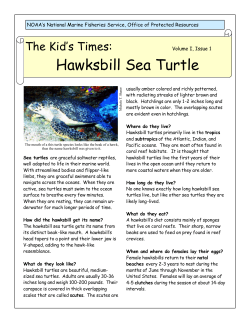
Important Turtle Areas - The State of the World`s Sea Turtles
Important Turtle Areas in the Persian Gulf By NICOLAS PILCHER, MARINA ANTONOPOULOU, LISA SHRAKE PERRY, and OLIVER KERR V ery few sea turtle nesting beaches are yet to be discovered in the world, but if you ask where turtles spend their lives at sea, many people will draw a blank. The generic answer of “Well, they go offshore and we don’t see them until they return to coastal habitats as juveniles—often known as the lost years” is a common response. But this answer applies only to the early years of a turtle’s life. What about the rest of the time? Sea turtles spend the vast majority of their lives at sea and only brief periods on beaches, either (a) as eggs during incubation, or briefly (b) as hatchlings frantically making their way to sea, or (c) as adult females laying eggs. That’s it. They are waterborne for the rest of the time. For sea turtle conservation to work, it must be effective on beaches, to be sure, but it also must be effective at sea. Because sea turtles traverse vast areas of ocean, identifying their most important at-sea habitats is a crucial first step. The same is true for other highly migratory species, including many birds, which led BirdLife International to pioneer the concept of Important Bird Areas (IBAs) in the 1980s. This valuable and now globally recognized methodology helps to prioritize bird conservation efforts to sites of particular importance, and it provides a worthy model to test with sea turtles. 12 | SWOT Report Knowing where turtles are in a particular life stage is a critical first step to defining Important Turtle Areas (ITAs), and recent advances in technology are allowing scientists across the planet to begin to unravel many of the mysteries of where turtles go while at sea. One area where this technology was recently applied with great results is the Arabian region, a part of the world not well known for its sea turtles. The study area comprised the Persian (also known as the Arabian) Gulf, along with the Oman and Arabian seas. The area supports large green turtle populations in Saudi Arabia and in Oman; smaller nesting aggregations in Iran and Kuwait; and hawksbills nesting in Iran, Kuwait, Oman, Qatar, Saudi Arabia, and the United Arab Emirates (UAE). Oman is also home to one of the largest loggerhead rookeries in the world, with thousands of nesting loggerheads and a handful of olive ridleys. We know a lot about the nesting populations and a bit about at-sea behavior of olive ridleys and loggerheads, but we know nothing about hawksbill at-sea habitat. That lack is what this study set out to resolve. The Persian Gulf is a unique environment. It undergoes extreme water and air temperature fluctuations, and its climate has a profound effect on sea turtles. Surface waters typically exceed 30ºC (86ºF) for sustained periods, so in many ways the Gulf can be likened to a natural living laboratory for understanding how turtles might adapt to climate change and elevated global temperatures. The region is also one of the world’s most important exploration and extraction areas for oil and gas, and it has some of the highest shipping traffic in the world. In addition, commercial, artisanal, and recreational fisheries further affect sea turtles, along with endless coastal development. Given those pressures, focused conservation strategies must target the full range and extent of turtles’ life cycles, not just their time on nesting beaches. Against this backdrop and in partnership with numerous colleagues from many government agencies, the private sector, and nongovernmental organizations (NGOs), we four were part of a recent project spearheaded by the Emirates Wildlife Society in association with WWF (EWS-WWF) and the Marine Research Foundation, which used satellites to track 75 postnesting female hawksbills from Iran, Oman, Qatar, and the UAE. Our aim was to identify key foraging grounds, temporal activity patterns, and potential migration bottlenecks, which we deemed to be ITAs. Other project partners provided tracking data of an additional 15 turtles from their own work to supplement the massive dataset we had accumulated. The satellite tracks showed that turtles tended to stay near their nesting sites for varying periods of time, thus allowing us to estimate that they laid between three and six clutches of eggs per season. As they left their nesting grounds, most turtles moved south or southwest toward the corner of the Gulf shared by Qatar, Saudi Arabia, and the UAE, with only a few traveling into the Gulf of Salwa (between Qatar and Saudi Arabia). Even fewer went northward toward Saudi Arabia and Kuwait. Surprisingly, no turtles headed east toward Iran and the eastern reaches of the UAE, an area that receives the cleaner waters entering the Persian Gulf from the Sea of Oman. Outside the Gulf, Omani turtles headed south from the Damaniyat Islands, hugging the coast of Oman, rounding Ras Al Hadd toward foraging sites along the mainland coast between Masirah and Yemen. Masirah turtles were the laziest of all, moving just a few kilometers across to the mainland. The most important results of this study, though, were the identification of the feeding grounds where turtles spend most of their time. Once they reached their destinations, the Persian Gulf turtles occupied discrete and isolated foraging grounds that are dispersed across a huge swath of the southwest Gulf, then usually returned to the same areas following two- to three-month summer migrations. Their home ranges varied in size but overall were relatively large, averaging some 50 km2 (19 mi2). In contrast, core areas were extremely precise and were limited to individual shallow patches averaging only about 1 km2 (1/3 mi2). Each turtle essentially lived on its own little feeding patch consisting of shallow areas with sparse hard substrate. Omani turtles were different: most of them moved to just a handful of collective feeding areas off Shannah, close to Masirah, and a few went to Quwayrah, approximately 300 km (186 mi) farther south. The Omani turtles’ core areas were also small but were home to numerous turtles, unlike in the Gulf, where turtles were highly dispersed and lived mostly alone. Contrary to our earlier expectations that Persian Gulf hawksbills would inhabit discrete areas that might have been demarcated for protection, the widespread dispersal of hawksbills across the southwest Gulf limits the habitat protection options available to managers. Hawksbill foraging habitats are predominantly located in shallow Maps of the Persian Gulf (TOP) and coast of Oman (BOTTOM) showing locations of satellite-tagged hawksbill turtles concentrated at foraging grounds. AT LEFT: A satellitetagged hawksbill returns to sea at Sir Bu Nair Island, United Arab Emirates. Seventy-five hawksbills were tracked from four different countries as part of efforts to identify Important Turtle Areas in the Persian Gulf. © OLIVER KERR / EWS-WWF waters where commercial shipping is less of an issue but where most traditional fisheries operate. As a result of our findings, we have suggested (a) that industrial development (particularly urban and industrial infrastructure) of shallow water areas should be limited, thereby maximizing available foraging habitats for hawksbills, and (b) that fishery activities should be controlled to limit their effect on hawksbills. In Oman, the identification of ITAs was clearer, with Shannah and Quwayrah identified as being key foraging habitats for most turtles and with the waters off Ras Al Hadd—specifically a 20 km (12 mi) band along the shores between Damaniyat, Muscat, and Masirah—constituting an important bottleneck for hawksbill turtles. We now know a lot more about where Persian Gulf turtles spend their time at sea. Those data improve our understanding of hawksbill habitat and behavior in a climate-challenged environment. The data also contribute to the delineation of ITAs that can now be used to assess risks from urban and industrial development, oil and gas industries, climate change, fishery pressure, and shipping activities, thereby setting the stage for effective conservation and management actions. We hope that ITAs become a mainstream conservation concern along with their IBA counterparts and that they be included in large-scale risk assessments and delineation of important habitats, such as through the Ecologically and Biologically Sensitive Areas process of the United Nations Convention on Biological Diversity. n SeaTurtleStatus.org | 13
© Copyright 2025









